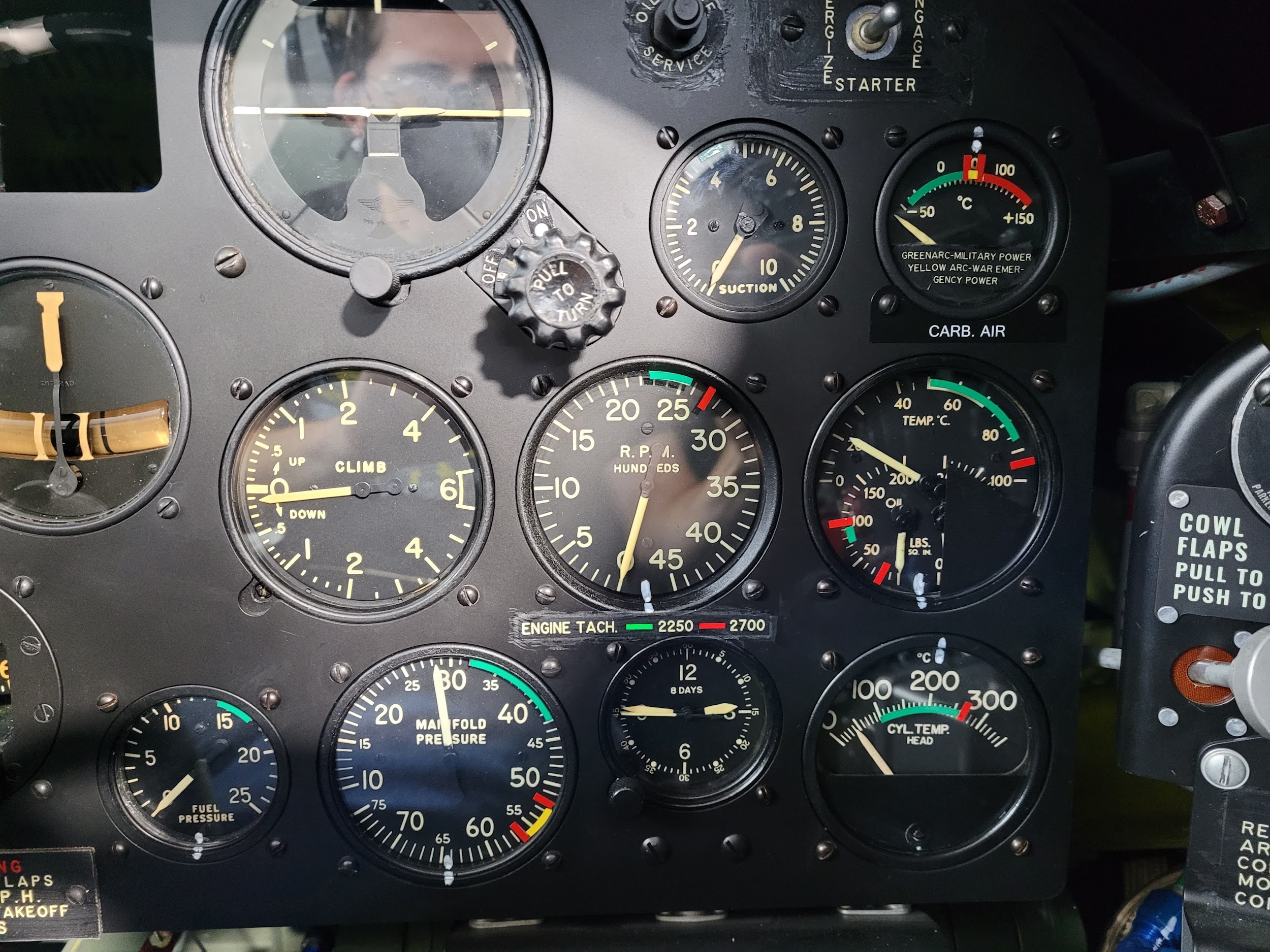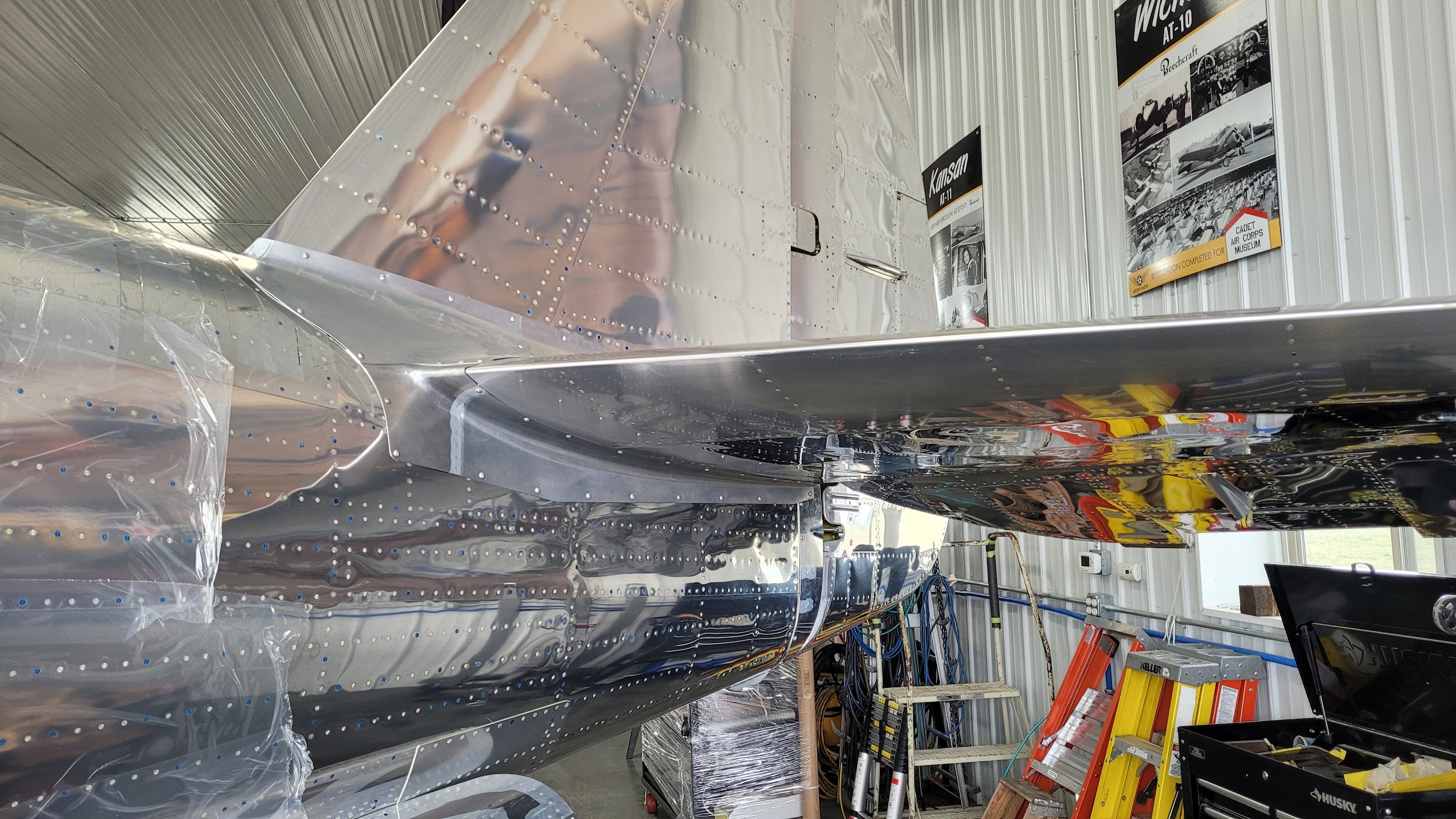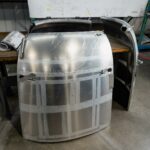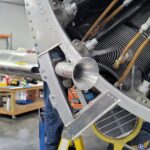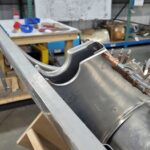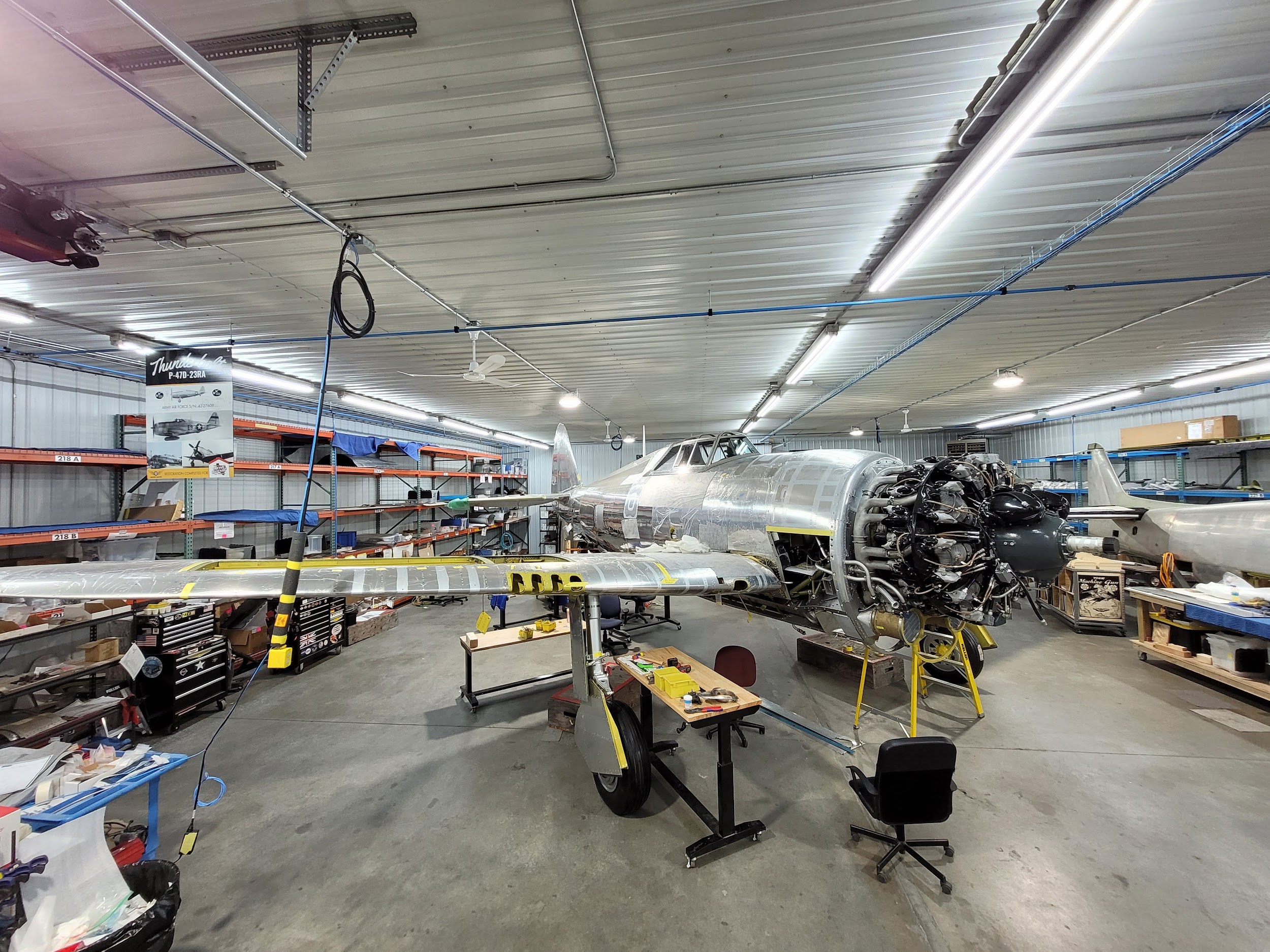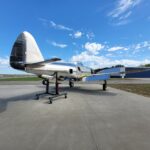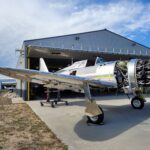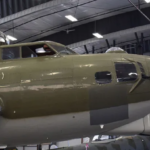Vintage Aviation News has received the September/October, 2022 report from Chuck Cravens concerning the restoration of the Dakota Territory Air Museum’s P-47D Thunderbolt 42-27609 at AirCorps Aviation in Bemidji, Minnesota. We thought our readers would be very interested to see how the project has progressed since our last article on this important project. So without further ado, here it goes!
Update
The major news this month is that the P-47 has moved out to AirCorps Aviation’s hangar at Bemidji Regional Airport. Work on the wings, cowl, and fuselage continued as the restoration nears completion.
Fuselage
This month saw details added to the instrument panel. The restoration team also continued work on the fuselage underside and the fuel system.
The green, yellow, and red arcs surrounding each gauge mark safe, caution, and unsafe operating limits respectively. For example, the red arrow on the airspeed indicator (left edge, center) warns the pilot not to exceed 500 mph in flight (a P-47 would have to be in a dive to breech that velocity). The yellow arrow on the turbosupercharger rpm gauge (slightly right of center, bottom) alerts the pilot that they are approaching the device’s maximum advisable operating limit.
When the aircraft is resting on its gear, the fuel gauge will report lower levels than the actual amount of fuel available, because the tanks are not in a level attitude while the aircraft is on the ground. A conversion table visible in the upper center of the above image allows the pilot to know what the actual fuel level is in such situations.
In the July/August Update, I wrote about the P-47’s strength and resistance to damage. Part of the airframe’s resilience following a belly landing is that the fuselage actually has crash skids built into its lower side. The skids themselves were covered by skin sections at the time of the July/Aug update, so I included an engineering drawing at that time, but this month it just happened that the skids were clearly exposed for a good photo.
Cowl
The P-47’s complex nose cowl assembly is approaching completion… this has been a challenging task!
Wings
Work on the wings this month focused upon completing the armament installation.
Hangar Move
Pilot Impressions of the P-47
As the P-47 nears flight status, it is worthwhile to revisit the conversations we have had with some WWII P-47 pilots over the last six years. Two of these pilots signed the P-47’s main access door, while a third left his signature inside an oxygen access panel. It was both an honor and a privilege to speak with these combat veteran pilots, and we appreciate their generosity in signing a part of our Thunderbolt.
Major General Dewitt Searles
Major General Searles was extremely generous with his time; he corresponded with me on several occasions via email and telephone.
In an email on May 12, 2016, Major General Searles relayed his opinions about the P-47’s capabilities as a fighter aircraft. He was 98 at the time and didn’t feel up to traveling, but he suggested that we send him a removable panel from the P-47 so he could sign it.
When General Searles remarked on his flying experiences in the P-47, he stated: “I remember it fondly and preferred it to any other fighter in the war – including the P-51’s that were assigned to us during my last few months in the Pacific.”
“I do remember escorting B-25s when flying with both the 342nd and the 460th squadrons. My first mission escorting B-25s was to Wewak. The B-25s flew directly down the airstrip dropping parachute retarded fragmentation bombs. We provided top cover. We also joined B-25s during attacks on Japanese shipping in Ormoc Bay. We provided top cover during their bomb run and then followed up with strafing attacks after they were done. Unfortunately, I have no recollection or record of the Group or Squadron numerical designations.
Yes, I remember the in-theater installation of the fuel tanks behind the pilot to give us a little better range. We were warned to avoid high G maneuvers until the tank was completely empty as the weight of a full tank would upset the aerodynamic balance which could lead to a loss of control.
The P-47 was the sturdiest and most stable propeller-driven aircraft that I have ever flown. It had an almost unlimited diving speed. I don’t recall a single incident of one breaking up in flight because of aerodynamic stress. And it could absorb more hits by enemy fighters or ground fire, and keep flying, than any other fighter plane that I know of.
Its versatility was not fully exploited until late in the war, in Europe and the Pacific, after enemy fighter strength had been severely reduced or eliminated. Then we found out that we had the most rugged and effective fighter bomber ever built. With eight fifty caliber machine guns and a 2000-pound bomb loads, it was unmatched as an air-to-ground fighter aircraft.”
Major General Searles was also kind enough to send me a written summary of his war experiences, which I will reproduce below in his words:
“BRIEF SUMMARY OF THE WORLD WAR II EXPERIENCES OF DEWITT R. SEARLES, A FIGHTER PILOT, IN THE UNITED STATES ARMY AIR CORPS DURING THE 1943-45 TIME PERIOD”
In February 1941, with flying school completed, I began an accelerated training course in the combat aircraft I would fly when assigned to a unit overseas. It was my great good fortune to be sent to Dale Mabry Army Airfield, Tallahassee, Florida, to begin training in the Republic P-47 Thunderbolt. Nicknamed the “Jug,” the P-47 was the biggest, most powerful, and arguably the best multi-purpose fighter aircraft employed in World War ll. After completing transition training in July we traveled by train to Hamilton Field, California for further deployment to the Southwest Pacific Area and assignment to the recently formed 348th Fighter Group commanded by Col. Neel E. Kearby, soon to become a leading fighter ace and recipient of the Congressional Medal of Honor.
I was assigned to the Group’s 342nd Fighter Squadron and flown across the Pacific in the bomb bay of a modified B-24 bomber. We departed San Francisco and touched down at Hawaii, Canton Island, and on into the air base at Townsville, Australia where our aircraft awaited us – in crates. So our first mission was to uncrate the aircraft, put them together, test fly them, and then head across the Coral Sea to an airstrip 5 miles from Port Moresby, New Guinea.
There we lived in canvas communities with tents on the bare ground for just about everything: sleeping, eating, supplies, maintenance and operations, flight line alert shack, field hospital, recreation, and even privies. Purified drinking water was delivered in water trailers and dispensed from huge canvas “lister” bags suspended from six-foot high tripods.
Our two greatest and most lethal challenges during my 22-month tour in New Guinea and the Philippines were the weather and mosquitoes. We lost more to them than we did to the Japanese. Just about every fighter pilot who flew in that area had a bad weather story to tell. The reason is that we had received little or no instrument flying training in any aircraft before being shipped overseas. “Needle, ball and airspeed” was about it, and that wouldn’t hack it in an area famous for massive, towering cumulus clouds and torrential rains. The worst weather experience for the Fifth Air Force – and perhaps the worst in aviation history – was on 16 April 1944: “Black Sunday.” On that one day, we lost 37 aircraft to weather or weather-related causes including A-20s. B- 25s, P-38s, B-24s plus a P-39, a P-47, one F-5A, and one F-7A. To my knowledge, there has never been a comparable one-day, noncombat, military aviation loss.
As for mosquitoes, they were our constant companions. They brought us Malaria and Dengue Fever. We fought them with Atabrine, DDT, and mosquito nets. Daily Atabrine tablets turned the skin and the whites of the eyes yellow. DDT was the most effective and widely used killer/repellent but it came with harmful side effects, and mosquito nets were essential for a good night’s sleep. Used religiously, all three kept most of us fever free but mosquitoes got to enough of us to keep the hospital tent busy. DDT was banned for use in the United States, and in the military, in 1972, but it kept a lot of us going some 4O years ago in New Guinea’.
Food was the third thing that we found a little discouraging: powdered things like milk and eggs; canned things like C-rations and spam; dehydrated things like lemonade and coffee; and experimental things like tropical butter that wouldn’t spread or melt and that stuck to the roof of your mouth. And the lack of things like fresh fruit and vegetables added to our dietary problems. All of these point toward the thing we enjoyed most: combat flying.
The Jug was a devastating combat machine: eight .50 caliber machine guns, a 2000 horsepower supercharged engine with a four-bladed prop; an unmatched high altitude capability that enabled us to gain speed while diving down into a fight instead of losing speed climbing up into one. We flew with confidence that if we used our heads we could survive just about anything that the Japs had to offer. And, surprisingly, was also the best fighter bomber in either theater of the war. We could easily handle a 100O pound bomb load. A favorite configuration was two 500-pound bombs, a belly tank, and a full load of .50 caliber ammo. Jettison the tank, bomb the target and then follow up with a strafing attack more deadly than any other fighter plane could deliver. “
Major General Searles lived to be 100 years old and passed away attended by his children on Saturday, February 27th, 2021.
First Lieutenant Kermit Bjorlie
I met Kermit Bjorlie and his son Jon on Saturday, July 13th, 2019 during the Wings of the North Air Museum’s AirExpo at Flying Cloud Airport in Eden Prairie, Minnesota.
At the time, Kermit was 100 years old and a veteran of the Southwest Pacific Theater in WWII. Kermit flew P-40s, P-47s, and P-51s during his training and his combat tour.
Lt. Bjorlie told me that the P-47 was his favorite of the three fighter aircraft types which he flew, because it was large, strong, and could carry a heavy load of fuel, ammunition, and bombs. In fact, he credits the P-47 with saving his life on a mission from Okinawa to Kyushu.
Bjorlie recounted his story from this mission, where he had to attack a Japanese destroyer making fast “S” turns tightly along the contours of a coastal cliff.
He dive-bombed the destroyer and as he pulled out from his bombing run, he passed low over the cliff top where an enemy anti-aircraft (AA) battery lay hidden, camouflaged in a shack near the cliff’s edge.
Lt. Bjorlie heard AA fire hit the bottom of his aircraft and then, shortly afterwards, he saw shrapnel holes appear in his wing. He turned his Thunderbolt, flying back towards the water, not wanting to end up crashing on land occupied by Japanese troops. He figured that his odds of survival were better over the ocean, and that he might be picked up by the Navy should he have to bail out.
As he evaluated the condition of his Thunderbolt, he determined that the self-sealing tanks had worked as advertised and his fighter was handling normally. He would therefore endeavor to make it back to Okinawa with his squadron mates. It had to be a great relief to spot his home air base after the long overwater flight in a battle-damaged P-47; he managed to land safely too!
During his Forest City Summit interview, Kermit stated: “I never did see the airplane again. I think it was taken into the repair depot, because it had too much damage.” He also observed that this was the closest call he had during his military flying career.1
Sadly, like Major General Searle and so many WWII veterans before him, Kermit Bjorliedied peacefully in his sleep in Zumbrota, Minnesota on December 1, 2021; he was 102 years old.
1 Personal interview, July 13, 2019
Lt Col Huie Lamb
A native of Abilene Texas, Huie Lamb flew 61 combat missions (167:40 combat hours in a P-47, 107:50 in a P-51) with the 8th Air Force’s 82nd Fighter Squadron, 78th Fighter Group. He is credited with shooting down two and a half enemy aircraft in the air and destroying three on the ground; his victories included two Luftwaffe jets. His P-51 suffered a mechanical failure on December 29th, 1944, resulting in a crash in the English Channel. Fortunately he was picked up by an Air Sea Rescue outfit based at Martlesham Heath in Suffolk, England.2
In a video phone interview which Huie Lamb was kind enough to grant us, he talked about the comparison between flying the P-51 and P-47 in combat. Asked which he preferred, Mr. Lamb said that it depended upon the mission. For an aerobatic air-to-air fight, he felt that the P-51 had the edge, but for ground attacks or for combat at over 25,000 feet of altitude, he preferred the P-47.
2 American Air Museum in Britain, https://www.americanairmuseum.com/person/98855, accessed 10-5-2022
In a combat report from October 15, 1944, Lt. Lamb described how he became one of the first Allied fighter pilots to shoot down the Luftwaffe’s then revolutionary jet fighter, the Messerschmitt Me 262.
“Capt Brown and I were returning from the Hannover Area after strafing ground targets. Near Osnabruck, I spotted a Jet Aircraft at about 4,000 ft. at this time. I started a steep dive and was indicating about 475 [IAS] and closing very fast. When I closed to about 1,000 yds., he must have seen me, as he started to pick up speed and pulled away a little. I gave my plane full power and water and started to close on him again, but very slowly. As I got within range and started shooting, he started to turn to the left. I easily turned inside of him and kept shooting during the entire turn, noting many strikes. The E/a, aN ME-262, made a 180-degree turn and then leveled out. He started back and led me over an airfield that had been shooting flak at me as I chased the jet. I saw the intense curtain of flak coming u[p at me, but followed him and got right on his tail, almost dead astern, and noticed more strikes. I felt myself being hit several times, but opened fire on him again, from dead a stern, and noticed more strikes. He threw off his canopy and then the plane caught fire. The E/a flipped over on its back and exploded. The flaming wreckage crashed into the ground and again exploded. I claim one ME-262 destroyed.”3
Huie Lamb is one of the few WWII veteran pilots still with us at time of writing; he enjoys riding in a P-51 as frequently as he can! In fact, in his video call, he mentioned that “he gets to fly in the Mustang every couple weeks.”
3 American Air Museum in Britain, https://www.americanairmuseum.com/person/98855, accessed 10-5-2022
And that’s all for this month. We wish to thank AirCorps Aviation and Chuck Cravens for making this report possible, and look forwards to bringing more restoration reports on progress with this rare machine in the coming months… and, hopefully, news of the aircraft’s first flight!










